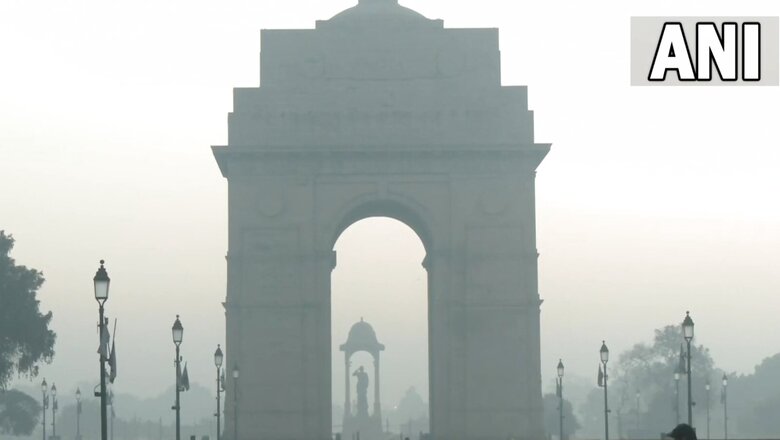
views
Delhi breathed comparatively less polluted air in 2022 thanks to proactive implementation of anti-pollution plans and favourable meteorology but the city government’s shambolic efforts failed to improve the water quality of the Yamuna, often referred to as the capital’s lifeline. Bold efforts of conservationists and the forest and wildlife department saw several wildlife species recover, including the striped hyena and leopards, in the urban jungles.
A dip in the incidents of stubble burning, few delayed spells of rains, an early Diwali and favourable meteorology prevented the capital from turning into a gas chamber following the festival.
Delhi saw its second-best air quality (average AQI 210) in October since 2015, when the Central Pollution Control Board (CPCB) started maintaining AQI data. The average AQI in November stood at 320, the second best after 2019 when it was 312.
The PM2.5 level this October-November has been 38 per cent lower compared to October-November of 2016 which was the worst in the last eight years.
“Diwali in a warmer October, lower incidents of crop fires, pre-emptive action based on pollution forecasting, and favourable meteorological conditions including extended rainfall in October, have all contributed towards bending of the early winter pollution curve,” said Anumita Roychowdhury, executive director, research and advocacy, Centre for Science and Environment.
The Commission for Air Quality Management (CAQM) unveiled a new policy listing sector-wise action plans to curb air pollution in Delhi-NCR in the next five years. A key component of the new policy is the revamped Graded Response Action Plan which focuses on proactive implementation of anti-pollution curbs based on forecast. According to the policy, which came into effect immediately, all thermal power plants located within 300-km radius of Delhi will have to ensure compliance with emission standards according to the deadline set by the Union environment ministry.
The Centre’s air quality panel has also implemented a complete ban on unapproved fuels, including coal, in industrial and commercial applications. The ban comes into force from January 1 and all defaulting establishments will be shut down straight away, without any warning, officials have said.
However, the use of low-sulphur coal in thermal power plants is allowed.
It has also directed Uttar Pradesh, Rajasthan and Haryana to register only CNG and electric autos from January 1 and complete the phase out of the diesel ones in the National Capital Region by the end of 2026. The objective is that only CNG and e-autos ply in the NCR from January 1, 2027.
Fuels pumps in Delhi-NCR have been told not to give fuel to vehicles not having a valid pollution-under-check certificate from January 1.
Stubble burning, a major reason behind hazardous pollution levels in Delhi-NCR in October-November, reduced by 30 percent in Punjab and 48 percent in Haryana this year.
The year also saw the Centre and Punjab squabble over the use of Pusa bio-decomposer, a microbial solution to decompose paddy straw, with Union Environment Minister Bhupender Yadav alleging that the AAP sprayed it in the capital but not in the border state.
Since 2020, the Delhi government has been using Pusa bio decomposer to prevent stubble burning in the capital. The AAP government in Punjab, however, used it in just 5,000 acres. Paddy is cultivated in around 30 lakh hectares in the agrarian state.
The Delhi government also found that the 25-metre-high smog tower at Connaught Place can cut down air pollution by 70 to 80 per cent within a radius of 50 m and by 15 to 20 per cent up to 300 m.
Chief Minister Arvind Kejriwal had inaugurated Rs 20-crore smog tower at Connaught Place on August 23 last year and his government had formed a team of experts from IIT-Bombay to study its impact over two years.
After a long delay, a project for identification of sources of air pollution on a real-time basis finally started in the national capital.
The Yamuna, one of the main sources of raw water in Delhi, struggled to survive the ecological assault of sewage and industrial effluents.
A government report showed that the pollutant load in the Yamuna has increased substantially over the last five years. The Delhi government had promised to clean the river to bathing standards by 2025.
Dramatic scenes played out on the banks of the Yamuna in October. BJP MP Parvesh Verma threatened a DJB official over the use of a chemical to dissipate foam in the river, a result of heavy pollution, ahead of Chhath Puja.
Challenged in the presence of TV cameras, the DJB official bathed in the water taken from a stretch of the Yamuna where the utility sprayed the chemical.
The Asola Bhatti Wildlife Sanctuary, the only protected wildlife habitat in Delhi, saw an increase in animal population.
A year-long study by the wildlife department and the Bombay Natural History Society confirmed the presence of eight leopards in the Asola Bhatti Wildlife Sanctuary, with enough evidence to suggest the large carnivore is making the urban forest its permanent home.
The sanctuary did not record any leopard sighting for many decades after 1940, as per the Gazetteer of Delhi.
Officials have also confirmed the presence of other mammals such as striped hyena, jungle cat, golden jackal, Indian hare, Indian boar, black buck, sambar deer, spotted deer, and hog deer among others.
The forest and wildlife department also thwarted attempts to dump inert civic waste in the abandoned Bhatti mines, which are now part of the Asola Wildlife Sanctuary.
Read all the Latest India News here

















Comments
0 comment